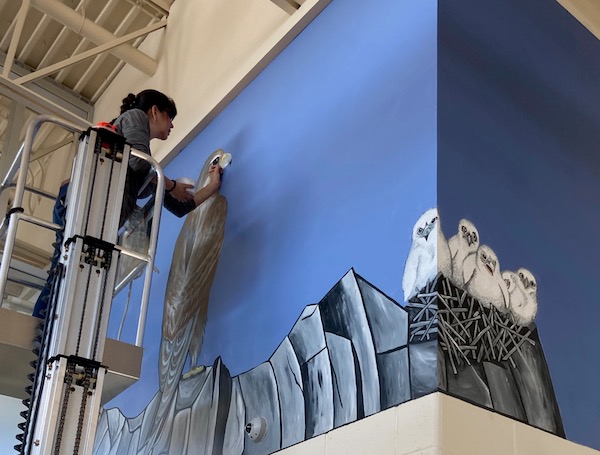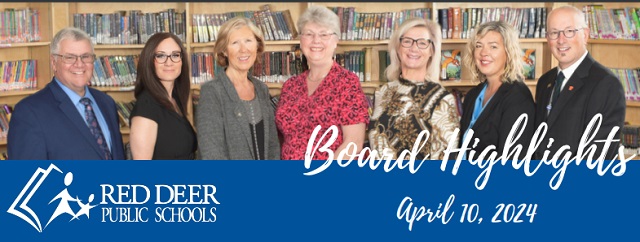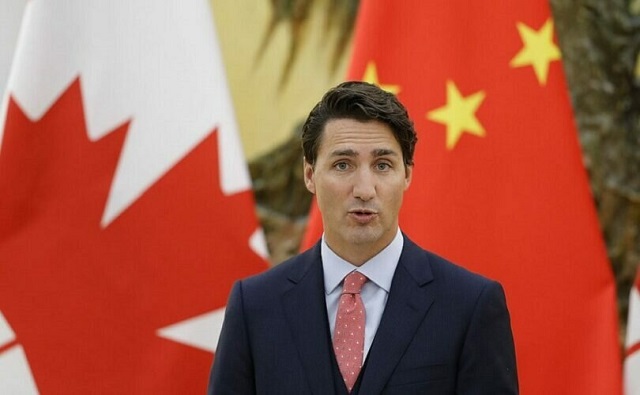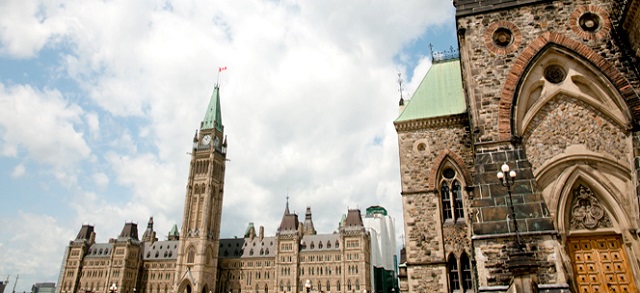Education
St. Joseph High School adds huge Falcon mural

Submitted by Red Deer Catholic Regional Schools
A new Indigenous mural on the second floor near the Career Centre that wraps around two walls at St. Joseph High School. The mural showcases a falcon sitting on rocks, a family of baby birds in a nest and another falcon flying as a way not only to represent the school, but also to move forward and put reconciliation into action.
Delree Dumont was commissioned for the work, as she is a well-known artist in Nakusp, BC who has experience in acrylic painting, smudge fans and medicine bags.
“Our athletic mascot is the Falcon which is a symbol in Indigenous spirituality. Stories and legends are part of the oral history of the Indigenous people. We are honoured to have this aspect of Indigenous beliefs and values incorporated into this mural. This mural ties our school mascot to Indigenous culture and teachings. The mural will remind our students and staff of this important link,” said Principal Graeme Daniel at St. Joseph High School.
“We wanted to incorporate the prairie falcon in our building, as that is the symbol of our school and symbolizes wisdom, protection, and victory. When I reached out to our First Nations, Métis, and Inuit Team team, they immediately had Delree in mind. As soon as we met, we knew she was perfect for this. Delree is an extremely talented artist and a blessing to have in our school. It was truly inspiring watching her bring this vision come to life over the past week,” said teacher Taylor Bargholz at St. Joseph High School.

This is the fourth mural in Red Deer Catholic Regional Schools. Currently there are Indigenous murals in École Camille J. Lerouge School, St. Francis of Assisi Middle School and St. Thomas Aquinas Middle School.
“As a school division, we feel that it is essential to honour Indigenous ways of knowing by welcoming Indigenous community members into our schools. We are honoured to welcome Delree Dumont into St. Joseph High School and see it as an opportunity for students to connect to Indigenous culture and teachings. Students have watched Delree’s work and the painting come to life to reflect the school’s design and the artist’s vision,” said First Nations, Métis, and Inuit Team Coordinator, Selena Frizzley at Red Deer Catholic Regional Schools.
Education
Solar eclipse school closures underscore impact of learning loss

From the Fraser Institute
Instead of making every effort to protect instructional time and ensure that schools remain open, students are being sent home for ever more dubious reasons.
Schools are closed out of an “abundance of caution.” No doubt you’ve heard this phrase many times over the last few years. It was commonly used during the pandemic when provincial governments closed schools for months on end—even after it was widely known that COVID-19 posed little risk to most children.
Ontario schools were closed for 135 days during the pandemic, more than any other province. Parents and teachers are still trying to recover from this enormous learning loss. Clearly, this was one situation where an abundance of caution caused more harm than it prevented.
Sadly, it appears that provincial officials and school board administrators haven’t learned from their mistakes. Instead of making every effort to protect instructional time and ensure that schools remain open, students are being sent home for ever more dubious reasons.
For example, school boards across Ontario cancelled classes on April 8, the day of the solar eclipse. Apparently administrators felt there was too great a risk that students might look at the sun during the eclipse and damage their eyes. No doubt more than a few of them glanced at the sun while sitting at home that day. However, there was no need for the school closures to be as total as the eclipse. If they were really that concerned, school officials could have kept students indoors or simply altered the dismissal times.
Initially, the Waterloo Region District School Board (WRDSB) took a common sense approach by stating that schools would remain open and teachers would use the eclipse as a learning opportunity for students. Then, only days before the eclipse, the WRDSB suddenly reversed itself and said their schools would indeed close on April 8, and students would have the opportunity to engage in “asynchronous remote learning” instead.
This decision sent the unfortunate message that WRDSB trustees are incapable of standing up to pressure from people who think that schools must close at the slightest sign of real or presumed danger. As for the notion that remote learning was an adequate substitute, our experience during the pandemic showed that for most parents and students, remote learning was thin gruel indeed.
As a further sign of how far paranoia has crept into the education system, some teacher unions demanded they too should be able to work from home during the eclipse. For example, Jeff Sorensen, president of the Hamilton local teacher union, said, “If it’s not safe for children [to be at school], then it’s not safe for adults.”
The union representing Toronto’s Catholic teachers made a similar request. In a memo to its members, local union president Deborah Karam said the union was “intensifying our efforts” to ensure that teachers be allowed to complete their professional development activities at home that day. Surprisingly, no union leader has yet explained why teachers would be less likely to look at the sun while at home than at school.
Of course, school boards must focus on education while also looking out for the wellbeing of students. But there’s more to student wellbeing than simply shielding them from all perceived risks. Extended school closures cause considerable harm to students because they lead to significant learning loss.
By normalizing the practise of closing schools at the slightest sign of danger, real or perceived, we risk raising a generation of young people who lack the ability to do a proper risk assessment. Life itself comes with risk and if we all took the same approach to driving a car that school boards take to school closures, would never set foot in a vehicle again.
Ontario students had a once-in-a-lifetime opportunity to experience a solar eclipse in an educational environment, guided by their teachers. While some parents no doubt taught their children about the eclipse, many others had to be at work.
By closing schools out of an “abundance of caution,” school boards sent the message that school is not a place where unique educational events can be experienced together. Students should be in school during events such as the eclipse, not sitting at home.
If we’re going to exercise an abundance of caution, let’s be a lot more cautious about the risks of closing schools at the drop of a hat.
Author:
Education
Red Deer Public Schools facing million dollar deficit due to inflation and carbon tax

Draft Three Year Education Plan
While the full Division Three-Year Education Plan will be presented to the Board next month, in order to facilitate strategic planning at both the school and Division levels, the Board was presented with the
proposed Strategies and Performance Measures that will set the strategic direction for Red Deer Public Schools in the coming years.
The highest priority for the Division is the success of every student. For the upcoming school year we have organized our strategic work around the following Alberta Education Assurance Domains:
- Student Growth & Achievement
- Teaching and Leading
- Learning Supports
- Governance
The fifth Alberta Education Assurance Domain, Local and Societal Context, encompasses all of the
aforementioned areas. Ten proposed strategies, which will be used to guide Red Deer Public‘s work, as well as 14 proposed performance measures, were also presented. PLAN
Budget Review and Schedule
Red Deer Public Schools is in the process of reviewing its budget for the 2024/2025 school year.
The Division’s budget totals $131 million. With a current projected deficit of $1 million, the state of the Division’s reserves will be about $2.8 million as of Aug. 31, 2024 year end.
Projected student enrolment is also similar for the 2024/2025 school year at about 10,800 FTE students. One challenge this year is that there has not been additional funding provided for inflationary cost increases such as benefit costs, carbon tax, supplies and materials and utilities.
The Board is expected to approve the 2024/2025 budget on May 8, with submission to Alberta Education on May 31. BUDGET
Field Studies Approved
The Board of Trustees approved two Field Studies for students at Hunting Hills High School and Gateway Christian School.
Hunting Hills students enroled in the Chinese Language and Culture courses will travel to China in April 2025. Students will be immersed in the Chinese language and learn to appreciate Chinese culture.

As well, in April 2025, students part of the Co-Impact Team from Gateway Christian School will travel to the Dominican Republic to take part in a number of service activities.
-

 COVID-192 days ago
COVID-192 days agoPro-freedom Canadian nurse gets two years probation for protesting COVID restrictions
-

 espionage2 days ago
espionage2 days agoTrudeau’s office was warned that Chinese agents posed ‘existential threat’ to Canada: secret memo
-

 Economy2 days ago
Economy2 days agoMassive deficits send debt interest charges soaring
-

 Business1 day ago
Business1 day agoBusiness investment key to addressing Canada’s productivity crisis
-

 International1 day ago
International1 day agoBrussels NatCon conference will continue freely after court overturns police barricade
-

 Jordan Peterson1 day ago
Jordan Peterson1 day agoJordan Peterson slams CBC for only interviewing pro-LGBT doctors about UK report on child ‘sex changes’
-

 Business1 day ago
Business1 day agoFederal budget fails to ‘break the glass’ on Canada’s economic growth crisis
-

 Frontier Centre for Public Policy1 day ago
Frontier Centre for Public Policy1 day agoThe Smallwood solution







